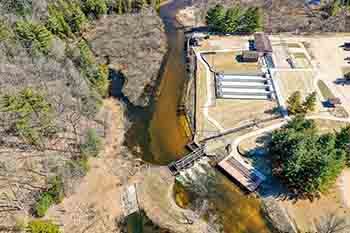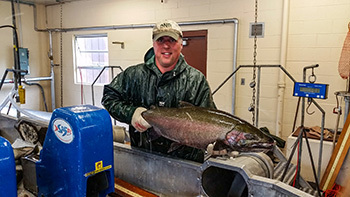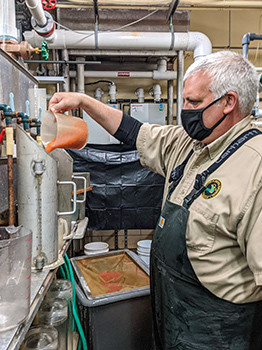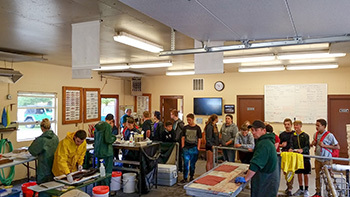Egg collection on the Little Manistee River
By SCOTT HEINTZELMAN, AARON SWITZER and JOE MICKEVICH
Michigan Department of Natural Resources
Have you ever wondered where those salmon and trout the Michigan Department of Natural Resources stocks in the Great Lakes and tributaries come from?
Before they hatch into fry (very young fish), before they grow to stocking size and before they leave the stocking truck, the eggs of these fish must be collected by DNR Fisheries Division personnel.
The Little Manistee River Weir and Egg Collection Facility, located on the beautiful Little Manistee River just outside of Manistee in Manistee County, is the place where this story originates.

For over 50 years, workers at the Little Manistee facility have collected eggs from Chinook salmon and steelhead, two very important and popular gamefish species.
History
The egg-take facility was constructed in 1967 and began operations in 1968 to meet the growing interest in fishing for salmon and steelhead – two non-native species introduced previously to the Great Lakes.
This site on the Little Manistee River was chosen based on its proximity to Lake Michigan and its ideal spawning habitat that already supported natural reproduction of steelhead (lake or ocean-going rainbow trout).
In the late 60s and early 70s, the introduction of coho and Chinook salmon revitalized Great Lakes fisheries that were depleted by invasive sea lamprey and alewife, commercial fishing and habitat degradation that had occurred over time.
Beginning in 1968 and continuing through today, the Little Manistee egg-take facility has operated as the primary source for Chinook salmon eggs, and the sole source for steelhead eggs, for these two fish-stocking programs.
|

The facility operates from about mid-March to May to collect eggs from steelhead that spawn in the river each spring. Mid-September through October, the facility staff collects eggs from Chinook salmon that spawn in the fall.
In 2019, the facility got much-needed upgrades, including replacing most of its mechanical and concrete infrastructure and adding efficiencies such as LED lighting and pump improvements.
Over the last 50 years, there has been only one time the facility and staff were unable to fulfill the egg quota for the steelhead program. In the spring of 2020, the COVID-19 pandemic was still in its early stages, and the many unknowns at the time resulted in the painful decision to suspend spring egg-take operations out of an abundance of caution.
For the fall Chinook salmon operations, return-to-work protocols were in place, facility workstations were modified to create distancing, plastic barriers were added, and the work crew size was reduced to only local unit staff.
These same protocols were in place for the 2021 spring steelhead operation, allowing staff to meet the needs of this important program while safely working together.
Process
The Little Manistee Weir and Egg Collection Facility and grounds includes several important components that provide a way to capture and hold fish and allow staff to collect and fertilize eggs and to release or harvest fish.
|

The process begins with the weir structure itself. The weir is basically a temporary dam that blocks fish from migrating upstream but does not impound water in the way a traditional dam would.
The other major component of the facility is a fish ladder leading to a raceway that connects to several ponds. The ponds, raceway and fish ladder are all flooded using large pumps that pump water from the river channel that circulates throughout the facility and down the fish ladder.
Watch fish enter the facility.
The flow of water through the facility attracts fish congregated below the weir up the fish ladder and into holding ponds. Chinook salmon and steelhead on their spawning run instinctively move upstream to seek out spawning habitat. This instinct leads them into the facility. Once a significant number of fish have been collected in ponds, egg-take operations can begin.
A typical day of egg take begins with a significant amount of planning and preparation.
First, the quota of eggs to meet the stocking requests of the program, including enough surplus stock to allow for changes in stocking numbers and losses during the rearing process, must be determined. This gives staffers who conduct the egg collection an idea of how many days the operation will take and the staffing level necessary to complete the work.
There is also a detailed protocol created and revised annually that describes the process required to fertilize, disinfect and prepare the eggs for the trip from the weir to the hatchery.
|

Once these steps are determined, it is time to bring in the fish. Fish are moved from the large holding ponds by opening the pond doors and using a machine called a crowder to slowly push them into the main raceway.
From there, the fish are slowly pushed into the spawning building and lifted by a basket into a tank where fish are anesthetized for handling. The fish are then taken out of the basket and put onto a sorting table where ripeness can be checked, and males and females are separated.
The ripe males are gently squeezed so milt, or sperm, can be collected in a small receptacle. Eggs are removed from ripe females by adding compressed air into the body cavity with a small needle.
In the steelhead egg collection process, spawned fish are moved to a recovery tank outside the building before being released upstream. Steelhead do not necessarily die after spawning and can spawn more than once in their life cycle.
In contrast, Chinook salmon only spawn once during their life cycle and then die, so fish that have been spawned are then harvested and sold by a state contractor.
During both egg collection operations, males and females are put in individual buckets for fertilization. Eggs are then combined in large egg buckets to finish preparation for transport.
When the buckets of fertilized eggs leave the Little Manistee River Weir facility, they go to a DNR fish hatchery, where they are counted and placed in incubators. This begins the fish’s journey through the hatching and early rearing process.
|

The fish are kept in the hatcheries until they begin the visible smolting process, when physiological changes occur as these migratory fish begin homing in on their surroundings, which will determine where they return to spawn.
The clearly visible part of the smolting process is the shedding of the camouflaged (with parr marks) scales that help conceal the fish while in rivers and streams. These scales are replaced with bright silvery scales as they migrate down rivers to the Great Lakes.
This occurs after only six months for Chinook salmon, while steelhead are in the hatchery for about one year. Stocking fish during the smolting process assists biologists in predicting where the fish may return to spawn.
Public outreach
The Little Manistee River Weir facility and grounds is also a great place to visit. Egg-take operations are usually open to the public (apart from recent COVID-19 restrictions) and allow visitors to see these amazing fish and the process of harvesting their eggs up close.
Weir tours, combined with education and outreach efforts, bring hundreds of students to the Little Manistee Weir every year to learn about the life cycle of fish, invasive species, the history of salmon in the Great Lakes and the DNR programs that manage and sustain these prized fisheries.
In 2012, the DNR partnered with the Manistee Explore the Shores Program to add universally accessible amenities at the site, including paved pathways around the grounds that offer a self-guided tour with informational signage, a large observation deck below the weir structure, handicap parking spaces and Americans with Disabilities Act-compliant pit toilets. This work was made possible by a grant from the Michigan Natural Resources Trust Fund.
If you would like to visit the weir, check out dates of operation and more at Michigan.gov/Hatcheries.
For more information on DNR fish stocking, fishing for steelhead and salmon, and many other fish-related subjects, visit Michigan.gov/Fishing.
|
Check out previous Showcasing the DNR stories in our archive at Michigan.gov/DNRStories. To subscribe to upcoming Showcasing articles, sign up for free email delivery at Michigan.gov/DNR.
/Note to editors: Contact: John Pepin, Showcasing the DNR series editor, at 906-250-7260. Accompanying photos and a text-only version of this story are available below for download and media use. Suggested captions follow. Credit: Michigan Department of Natural Resources, unless otherwise noted.
Text-only version of this story.
Buckets: Buckets of steelhead and Chinook salmon eggs are shown at the Little Manistee River Weir and Egg Collection Facility in Manistee County.
Eggs – 1 and Eggs – 2: Ed Barr, a Michigan Department of Natural Resources fisheries technician, works with collected fish eggs at the Wolf Lake State Fish Hatchery.
Fish: Michigan Department of Natural Resources staffers work to sort fish for spawning at the Little Manistee River Weir and Egg Collection Facility in Manistee County.
Ponds: An aerial photograph shows the Little Manistee River Weir and Egg Collection Facility weir and ponds in Manistee County.
Salmon: Mark and Mike Kuehn are shown with Chinook salmon catches on Lake Michigan.
Steelhead: Olen Gannon, Michigan Department of Natural Resources fisheries technician at the Harrietta Field Office, is shown with a 20-pound steelhead.
Visit – 1 and Visit – 2: The Little Manistee River Weir and Egg Collection Facility in Manistee County is a fun and educational place to visit. Check with facility for COVID-19 protocols or restrictions./
|